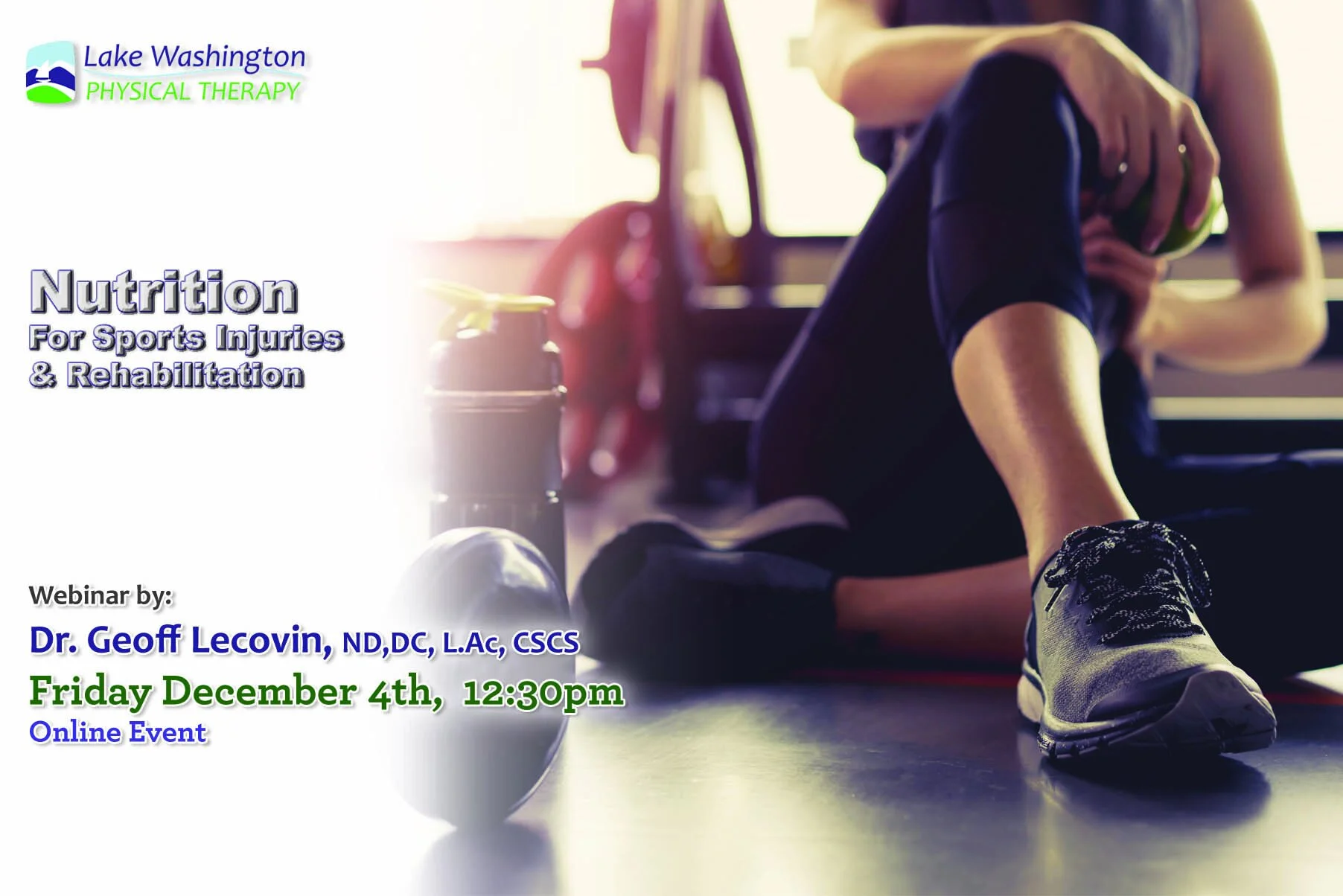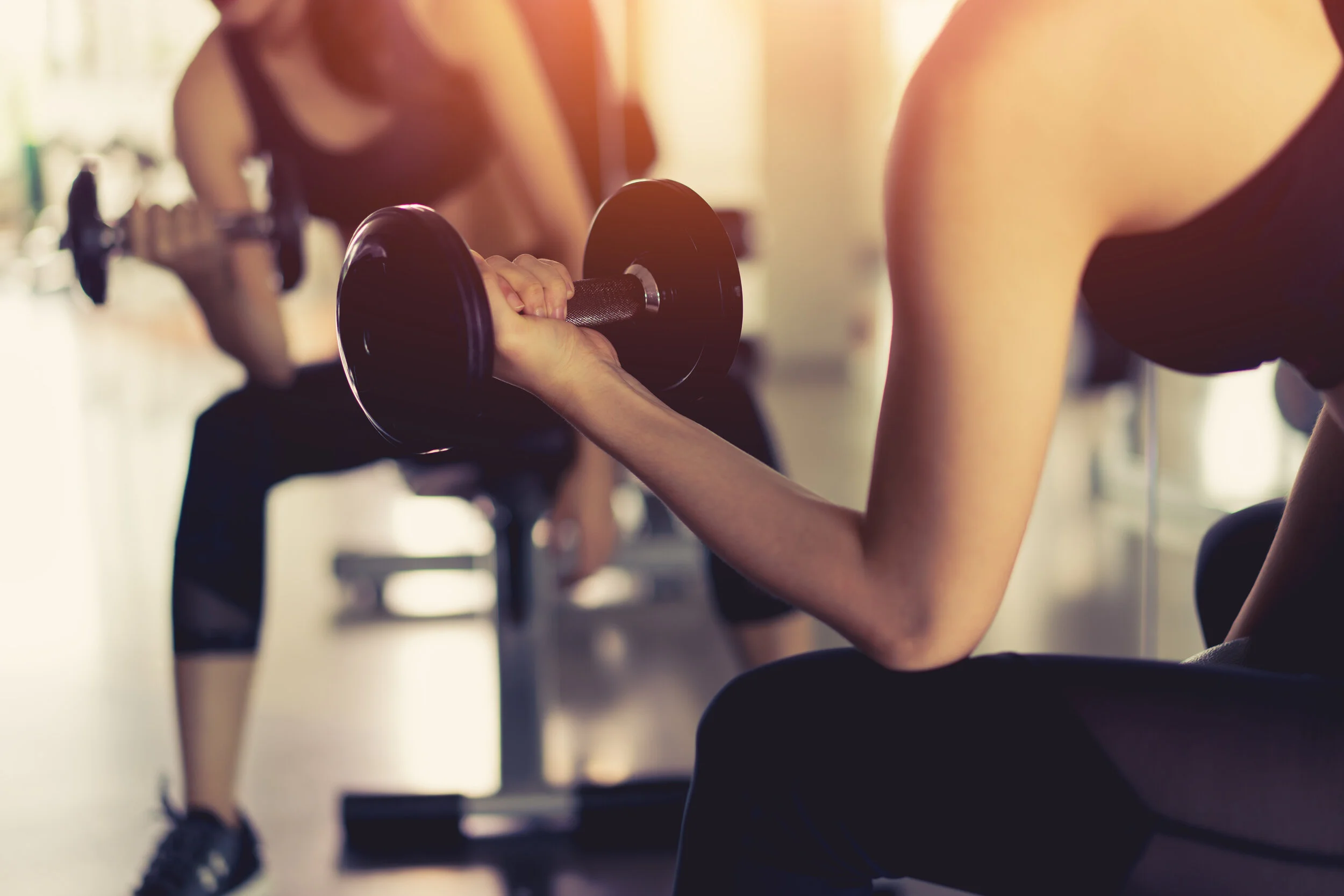Dr. Geoff Lecovin joins us for a 3 part series on healthy diet and nutrition for rehabilitation.
Nutrition for Sports Injuries & Healing: Part 2 of 3
Nutrition for Sports Injuries & Healing: 2 of 3
Dr. Geoff Lecovin
MS, DC, ND, L.Ac, CSCS, CISSN
Naturopathic Physician, Chiropractor, Acupuncturist, Nutritionist, & Personal Trainer
“Unleashing the Power of Food”
The key points to consider with the pyramid of nutritional
Prioritization:
Consume adequate calories to ensure energy balance
Ensure optimal intake of macronutrients (Carbohydrates, proteins and fats) for energy, repair and reducing inflammation
Eat enough nutrient dense foods to avoid micronutrient deficiencies (vitamins, minerals and phytonutrients)
Strategic timing of nutrients for energy and repair
Select nutrient supplementation for inflammation, muscle, tendon and bone repair
Energy
Adequate calories (energy) are essential for maintaining ideal body weight, fueling activities (e.g. rehabilitation) and promoting healing/recovery. Determining one’s energy requirements can be done using online calculators that take into account one's metabolic rate (BMR) and activity energy expenditure (i.e. rehabilitation, exercise, healing requirements and non exercise activity thermogenesis). Many individuals reduce their calorie intake during injury recovery out of fear that they will gain weight. While consuming excessive simple carbohydrates could lead to unwanted weight gain, supporting the healing process with adequate calories is essential. In addition, some weight gain may be favorable for optimal healing. Also, during recovery, the use of crutches or other ambulation aids can substantially increase one’s energy requirements.
Macronutrients
There are three macronutrients:
Carbohydrates
Proteins
Fats
Each macronutrient plays an important role in the healing process and will be discussed in the context of the three T’s: Total, Type and Timing.
Carbohydrates
Carbohydrates include sugars (simple) and starches (complex). Their primary function is to provide energy for moderate-intense activity. They are also important in keeping the body in an anabolic state by helping to mediate cortisol levels, a main catabolic hormone. Carbohydrates also spare protein, which further aids in maintaining an anabolic state. During injury healing, one should consider meeting carbohydrate requirements for both the healing process as well as rehabilitation. This could be in the range of 3-5g/kg Body Mass, with the focus on low glycemic carbohydrates (e.g. whole grains, vegetables and fruits) as the primary sources.
Proteins
Proteins are essential for muscle growth and repair as well as keeping the body in an anabolic state. They can be categorized as:
Complete - Animal sources, such as beef, poultry, pork, lamb, fish, eggs, dairy and plants such as quinoa and soy
Incomplete - Plants, such as grains, legumes, nuts and vegetables
The general dose for protein to help support healing is 1.5-2.5 g/kg Body Mass. Include some protein with each meal (about 0.4 g/kg Body Mass or about 20-40g). If you are vegetarian, make sure to balance complementary protein sources throughout the day, e.g. Rice and beans, and aim for intakes towards the higher end. Protein needs can be higher in older adults as well as in disuse atrophy, where there can be anabolic resistance.
Fats
Fats and oils can be categorized according to their saturation. The degree of saturation determines the melting point and stability of a fat. Fats are important as an energy source (low intensity activity), hormone production and in controlling inflammation.
Sources of fats include:
Saturated fats- Animal fats and coconut Monounsaturated- Avocados, olive oil, macadamia nuts
Polyunsaturated:
Omega 6 (Proinflammatory if out of balance)- Seed and vegetable oils, e.g. canola, corn, peanut, sunflower, safflower
Omega 3 (anti-inflammatory)- Dark green leafy vegetables, flax/hemp seeds, walnuts, cold water fish, grass-fed beef, omega-3 eggs
In general, fats should make up anywhere from 15-20% of one’s diet, with the emphasis on omega 3 polyunsaturated fatty acids and monounsaturated sources. Diets high in saturated fats and omega 6 polyunsaturated fatty acids can put the body in a more inflammatory state.
Micronutrients
Micronutrients include vitamins, minerals and phytonutrients. They are required in small quantities to ensure normal metabolism, growth and physical well-being. They also help to reduce inflammation and support the healing process. When it comes to micronutrients, avoiding nutrient deficiencies is the key and this can be done by eating a well balanced, varied, whole foods and unprocessed diet. Supraphysiologic vitamin and mineral supplementation beyond what a balanced diet can provide, is not recommended and in the case of antioxidants (e.g. Vitamins A,C,E,Beta carotene, Zinc and Selenium) can adversely affect healing by disrupting the beneficial aspects of inflammation.
References:
Areestion during prolta, J. L., Burke, L. M., Ross, M. L., Camera, D. M., West, D. W., Broad, E. M., ... & Hawley, J. A. (2013).
Timing and distribution of protein ingonged recovery from resistance exercise alters myofibrillar protein synthesis. The Journal of physiology , 591 (9), 2319-2331 Louise M. Burke, John A. Hawley, Stephen H. S. Wong & Asker E. Jeukendrup (2011)
Carbohydrates for training and competition, Journal of Sports Sciences, 29:sup1, S17-S27, DOI: 10.1080/02640414.2011.585473 Clifford, T., Bell, O., West, D. J., Howatson, G., & Stevenson, E. J. (2016).
The effects of beetroot juice supplementation on indices of muscle damage following eccentric exercise. European journal of applied physiology , 116 (2), 353-362. Close, G. L., Sale, C., Baar, K., & Bermon, S. (2019).
Nutrition for the prevention and treatment of injuries in track and field athletes. International journal of sport nutrition and exercise metabolism , 29 (2), 189-197 Currell , Kevin. Performance Nutrition . Crowood Press (April 1, 2017)
Farup, J., Rahbek, S. K., Knudsen, I. S., de Paoli, F., Mackey, A. L., & Vissing, K. (2014). Whey protein supplementation accelerates satellite cell proliferation during recovery from eccentric exercise. Amino Acids , 46 (11), 2503-2516 Frankenfield, D. (2006).
Energy expenditure and protein requirements after traumatic injury. Nutrition in Clinical Practice , 21 (5), 430-437 Glover, E. I., Phillips, S. M., Oates, B. R., Tang, J. E., Tarnopolsky, M. A., Selby, A., ... & Rennie, M. J. (2008).
Immobilization induces anabolic resistance in human myofibrillar protein synthesis with low and high dose amino acid infusion. The Journal of physiology , 586 (24), 6049-6061 Guo, S., & Dipietro, L. A. (2010).
Factors affecting wound healing. Journal of dental research , 89 (3), 219–229. https://doi.org/10.1177/0022034509359125 Juhasz, I., Kopkane, J. P., Hajdu, P., Szalay, G., Kopper, B., & Tihanyi, J. (2018).
Creatine Supplementation Supports the Rehabilitation of Adolescent Fin Swimmers in Tendon Overuse Injury Cases. Journal of sports science & medicine , 17 (2), 279–288 Kelley, D. S., Adkins, Y., & Laugero, K. D. (2018).
A Review of the Health Benefits of Cherries. Nutrients , 10 (3), 368. https://doi.org/10.3390/nu10030368 Kerksick, C. M., Arent, S., Schoenfeld, B. J., Stout, J. R., Campbell, B., Wilborn, C. D., Taylor, L., Kalman, D., Smith-Ryan, A. E., Kreider, R. B., Willoughby, D., Arciero, P. J., VanDusseldorp, T. A., Ormsbee, M. J., Wildman, R., Greenwood, M., Ziegenfuss, T. N., Aragon, A. A., & Antonio, J. (2017).
International society of sports nutrition position stand: nutrient timing. Journal of the International Society of Sports Nutrition , 14 , 33. https://doi.org/10.1186/s12970-017-0189-4 Laumonier, T., & Menetrey, J. (2016).
Muscle injuries and strategies for improving their repair. Journal of experimental orthopaedics , 3 (1), 15. https://doi.org/10.1186/s40634-016-0051-7 Logue, D. M., Madigan, S. M., Melin, A., Delahunt, E., Heinen, M., Donnell, S. M., & Corish, C. A. (2020). Low Energy Availability in Athletes 2020:
An Updated Narrative Review of Prevalence, Risk, Within-Day Energy Balance, Knowledge, and Impact on Sports Performance. Nutrients , 12 (3), 835. https://doi.org/10.3390/nu12030835 Phillips, C. M., Chen, L. W., Heude, B., Bernard, J. Y., Harvey, N. C., Duijts, L., ... & Shivappa, N. (2019).
Dietary inflammatory index and non-communicable disease risk: a narrative review. Nutrients , 11 (8), 1873. Maughan, R. J., Burke, L. M., Dvorak, J., Larson-Meyer, D. E., Peeling, P., Phillips, S. M., ... & Meeusen, R. (2018).
IOC consensus statement: dietary supplements and the high-performance athlete. International journal of sport nutrition and exercise metabolism , 28 (2), 104-125 Myer, G. D., Kushner, A. M., Brent, J. L., Schoenfeld, B. J., Hugentobler, J., Lloyd, R. S., Vermeil, A., Chu, D. A., Harbin, J., & McGill, S. M. (2014).
The back squat: A proposed assessment of functional deficits and technical factors that limit performance. Strength and conditioning journal , 36 (6), 4–27. https://doi.org/10.1519/SSC.0000000000000103 Mountjoy, M., Sundgot-Borgen, J., Burke, L., Carter, S., Constantini, N., Lebrun, C., ... & Ljungqvist, A. (2014).
The IOC consensus statement: beyond the female athlete triad—Relative Energy Deficiency in Sport (RED-S). Br J Sports Med , 48 (7), 491-497 Pence, B. D., & Woods, J. A. (2014). Exercise, obesity, and cutaneous wound healing: evidence from rodent and human studies. Advances in wound care , 3 (1), 71-79. Quintero, K. J., de Sá Resende, A., Leite, G. S. F., & Junior, A. H. L. (2018).
An overview of nutritional strategies for recovery process in sports-related muscle injuries. Nutrire , 43 (1), 27 Sale, C., & Elliott-Sale, K. J. (2019). Nutrition and athlete bone health. Sports Medicine , 1-13 Shaw, G., Lee-Barthel, A., Ross, M. L., Wang, B., & Baar, K. (2017).
Vitamin C–enriched gelatin supplementation before intermittent activity augments collagen synthesis. The American journal of clinical nutrition , 105 (1), 136-143 Smith, Stephen, MSc, PHd, (Cand), NUTRITION FOR INJURY PREVENTION & REHABILITATION applied in an elite powerlifter.2019.
IOPN Performance Nutrition DiplomaTipton, K. D. (2015).
Nutritional support for exercise-induced injuries. Sports Medicine , 45 (1), 93-104 Van Vliet, S., Shy, E. L., Abou Sawan, S., Beals, J. W., West, D. W., Skinner, S. K., ... & Moore, D. R. (2017).
Consumption of whole eggs promotes greater stimulation of postexercise muscle protein synthesis than consumption of isonitrogenous amounts of egg whites in young men. The American journal of clinical nutrition , 106 (6), 1401-1412 Wall, B. T., Snijders, T., Senden, J. M., Ottenbros, C. L., Gijsen, A. P., Verdijk, L. B., & van Loon, L. J. (2013). Disuse impairs the muscle protein synthetic response to protein ingestion in healthy men. The Journal of Clinical Endocrinology & Metabolism , 98 (12), 4872-4881 Yang, D. F., Shen, Y. L., Wu, C., Huang, Y. S., Lee, P. Y., Er, N.X., ... & Tung, Y. T. (2019).
Sleep deprivation reduces the recovery of muscle injury induced by high-intensity exercise in a mouse model. Life sciences , 235 , 116835 Precision Nutrition, Nutrition for Injury Recovery Infographic. https://www.precisionnutrition.com/ http://www.sportsrd.org/wp-content/uploads/2016/08/Nutrition- Support-for-Inury-Recovery-Return-to-Play.pdf
Questions and Contact Info: www.drgeofflecovin.com or email: geoff@drgeofflecovin.com
Stretching
Everyone knows that stretching is good for you, but most people are wrong in WHY they think it is good for you. As a PT and frequent gym-goer, I often hear that stretching is good because it helps lengthen the muscles. This is completely wrong. I think it is time to debunk some of the myths surrounding stretching. After reading this page, you will have a better understanding of what does and does not happen when you stretch. You might even be able to enlighten those around you in yoga class or at the gym.
Squat Depth
SQUAT DEPTH
weight lifting, physical therapy
BY: JORDAN BORK, PT, DPT, CSCS
SQUAT DEPTH: A PHYSICAL THERAPIST’S PERSPECTIVE
One of the most debated topics in the weight lifting world is that of squat depth. At most gyms you will see everything from mini-knee bends, to “A*s to Grass” squatting. So how do you know how deep is deep enough?
ANATOMY AND BIOMECHANICS:
As per usual, let’s cover a quick lesson in anatomy and biomechanics before we dive into the debate.
The classic barbell squat primarily works your gluteal and quadriceps muscle groups. Together with the hamstrings, calves, abductors and adductors, the body works to control the weight as you descend and ascend throughout the lift. Because of its large compound movement the squat it is often considered a full body work out and one of the 3 major lifts (along with deadlifts and bench press).
Is CrossFit Bad for You?
Is CrossFit bad for you?
A physical therapist’s perspective
As a PT, I often get asked, “Is CrossFit bad for you?” I usually respond that it is only as harmful as any other form of strenuous exercise.
The workout that has taken our nation by storm often gets a bad rep from horror stories of back injuries, excessive weights and poor form. However, I feel this has become exaggerated. The reality is you can find the same unfortunate types of injuries in every gym setting.
CrossFit utilizes high intensity work outs with large compound movements perfect for improving lean muscle mass, decreasing body fat and building strength. As a result, these compound movements often require a certain level of skill, practice and coordination.
CrossFit is appealing because it challenges you both physically and mentally. It provides a barrier you must strive to overcome and with completion comes the euphoria of accomplishment. On the other hand, what makes it so great is also its greatest risk. Utilizing large muscle groups, at high intensities with short rest times will make you push yourself and experience significant levels of fatigue. Anytime your body fatigues and keeps pushing, it will be at an increased risk of injury. However, just because something has a risk of form breakdown does not mean that it is harmful or dangerous. If we avoided all activities involving fatigue and poor technique, than no one would be running or even rearranging furniture in their home.
It is true that correct form is imperative for exercise, possibly more so in CrossFit due to the high volume/intensity of the workouts. This is why you must be diligent about the basics and progress your weights slowly. Pay attention to form and don’t be afraid to ask the coaches to examine your lifts.
I do want to mention that CrossFit is not for everyone. Those who are new to the world of physical fitness will benefit from classes on the basics of lifting prior to performing dynamic compound lifts. If you are recovering from injury I recommend starting the road back to the gym with light weights and isolated muscle focus rather than large explosive movements. The re-introduction of stress placed throughout the body is best done in a manner that won’t involve excessive fatigue or the urge to push your limits. Lastly, if you think you have an injury or have not performed physical exercise I recommend that you seek assessment from a physical therapist or other trained medical professional prior to starting physical activities.
BOTTOM LINE:
Like all physical activity, CrossFit has inherent risk for injury. These risks can be magnified if poor form is used. However, with the right instructors, correct progression of resistance and proper technique CrossFit can be an excellent form of exercise for people of many fitness levels.













